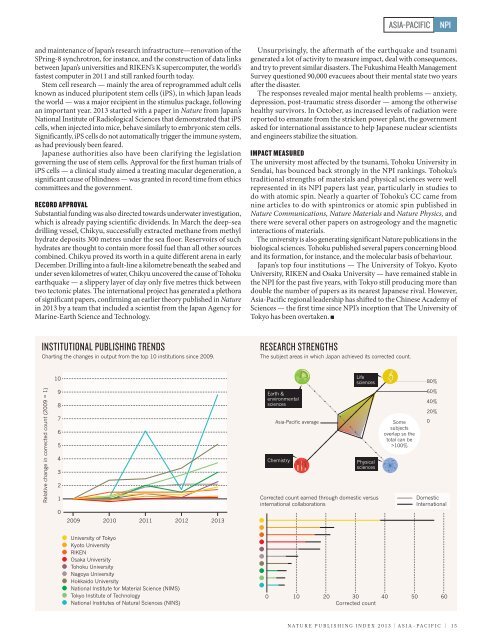NPI2013_Asia-Pacific
NPI2013_Asia-Pacific
NPI2013_Asia-Pacific
You also want an ePaper? Increase the reach of your titles
YUMPU automatically turns print PDFs into web optimized ePapers that Google loves.
ASIA-PACIFICNPIand maintenance of Japan’s research infrastructure—renovation of theSPring-8 synchrotron, for instance, and the construction of data linksbetween Japan’s universities and RIKEN’s K supercomputer, the world’sfastest computer in 2011 and still ranked fourth today.Stem cell research — mainly the area of reprogrammed adult cellsknown as induced pluripotent stem cells (iPS), in which Japan leadsthe world — was a major recipient in the stimulus package, followingan important year. 2013 started with a paper in Nature from Japan’sNational Institute of Radiological Sciences that demonstrated that iPScells, when injected into mice, behave similarly to embryonic stem cells.Significantly, iPS cells do not automatically trigger the immune system,as had previously been feared.Japanese authorities also have been clarifying the legislationgoverning the use of stem cells. Approval for the first human trials ofiPS cells — a clinical study aimed a treating macular degeneration, asignificant cause of blindness — was granted in record time from ethicscommittees and the government.RECORD APPROVALSubstantial funding was also directed towards underwater investigation,which is already paying scientific dividends. In March the deep-seadrilling vessel, Chikyu, successfully extracted methane from methylhydrate deposits 300 metres under the sea floor. Reservoirs of suchhydrates are thought to contain more fossil fuel than all other sourcescombined. Chikyu proved its worth in a quite different arena in earlyDecember. Drilling into a fault-line a kilometre beneath the seabed andunder seven kilometres of water, Chikyu uncovered the cause of Tohokuearthquake — a slippery layer of clay only five metres thick betweentwo tectonic plates. The international project has generated a plethoraof significant papers, confirming an earlier theory published in Naturein 2013 by a team that included a scientist from the Japan Agency forMarine-Earth Science and Technology.Unsurprisingly, the aftermath of the earthquake and tsunamigenerated a lot of activity to measure impact, deal with consequences,and try to prevent similar disasters. The Fukushima Health ManagementSurvey questioned 90,000 evacuees about their mental state two yearsafter the disaster.The responses revealed major mental health problems — anxiety,depression, post-traumatic stress disorder — among the otherwisehealthy survivors. In October, as increased levels of radiation werereported to emanate from the stricken power plant, the governmentasked for international assistance to help Japanese nuclear scientistsand engineers stabilize the situation.IMPACT MEASUREDThe university most affected by the tsunami, Tohoku University inSendai, has bounced back strongly in the NPI rankings. Tohoku’straditional strengths of materials and physical sciences were wellrepresented in its NPI papers last year, particularly in studies todo with atomic spin. Nearly a quarter of Tohoku’s CC came fromnine articles to do with spintronics or atomic spin published inNature Communications, Nature Materials and Nature Physics, andthere were several other papers on astrogeology and the magneticinteractions of materials.The university is also generating significant Nature publications in thebiological sciences. Tohoku published several papers concerning bloodand its formation, for instance, and the molecular basis of behaviour.Japan’s top four institutions — The University of Tokyo, KyotoUniversity, RIKEN and Osaka University — have remained stable inthe NPI for the past five years, with Tokyo still producing more thandouble the number of papers as its nearest Japanese rival. However,<strong>Asia</strong>-<strong>Pacific</strong> regional leadership has shifted to the Chinese Academy ofSciences — the first time since NPI’s inception that The University ofTokyo has been overtaken. ■INSTITUTIONAL PUBLISHING TRENDSCharting the changes in output from the top 10 institutions since 2009.RESEARCH STRENGTHSThe subject areas in which Japan achieved its corrected count.10Lifesciences80%60%40%20%0Relative change in corrected count (2009 = 1)987654321020092010201120122013Earth &environmentalsciences<strong>Asia</strong>-<strong>Pacific</strong> averageChemistryPhysicalsciencesCorrected count earned through domestic versusinternational collaborationsSomesubjectsoverlap so thetotal can be>100%DomesticInternationalUniversity of TokyoKyoto UniversityRIKENOsaka UniversityTohoku UniversityNagoya UniversityHokkaido UniversityNational Institute for Material Science (NIMS)Tokyo Institute of TechnologyNational Institutes of Natural Sciences (NINS)0 10 20 30 40 50 60Corrected countNATURE PUBLISHING INDEX 2013 | ASIA-PACIFIC | 15


